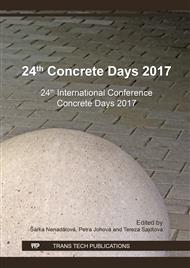p.141
p.147
p.154
p.160
p.166
p.172
p.178
p.185
p.189
Segregation of Steel Fibres of UHPFRC
Abstract:
The mixture of ultra-high performance concrete is often supplemented by steel fibres which can significantly improve the fracture energy of the concrete. The incorporation of steel fibres results in especially a significant increase of tensile strength and minimize the risk of brittle failure. However, these positive properties can be fully realised only if the fibres are uniformly distributed. Otherwise, that leads to different quality of the concrete and to deterioration of strength characteristics. The subject of this article is the segregation of steel fibres which is one of the frequent problems of poor distribution of fibres. The degree of segregation has been investigated depending on amount of fibre dosage, size of maximum aggregate size and degree of consistency of fresh concrete. Two types of steel fibres with circular cross-section of a diameter of 0.4 mm but with different lengths (12.5 and 25 mm) were used for experiments. The segregation was evaluated by the drop of the fibres on the cutting surface of specimens. The results showed that segregation was the most affected by the consistency of fresh concrete. The amount of fibre dosage as well as the size of maximum aggregate size did not significantly affect segregation.
Info:
Periodical:
Pages:
166-171
Citation:
Online since:
February 2018
Authors:
Keywords:
Price:
Сopyright:
© 2018 Trans Tech Publications Ltd. All Rights Reserved
Share:
Citation:


